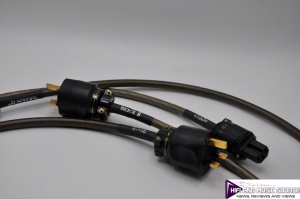
Tellurium Q Black II Power Cable
This is a nice one, a review of the new Tellurium Q Black II power cable, in comparison to the Tellurium Q Black (I) Power Cable, in comparison to a Naim standard supplied lead (that I’ve liberated from the Naim Uniti Star (I think)).
Design
Anyone who knows about Tellurium Q will know Geoff Merrigan, their founder and chief executive, will tell you very little about what is going on inside their cables, such is their investment in research and development. Why would you give away your hard-earned advantage? We probably wouldn’t really understand what is going on anyway. The truth is in the listening. This is an upgrade by Tellurium Q to the Black I power cable, apparently, the cable has been completely re-engineered on the inside. What’s new?. ‘Everything’ says Geoff, ‘apart from the Furutech terminals’. New shielding and sheathing, completely new dielectrics (plural) on the inside. It is all designed to reduce the amount of ‘fuzz’ going into the amplifier. ‘Electrical noise?’ I enquire, ‘well yes, sort of’, replies Geoff.
Quality
Looking at the Black I v the Tellurium Q Black II power cable there is little to tell them apart, save for the sheath at the terminal telling you which one you have. The Black II could be a shade lighter but they both appear similar and have the same Furutech terminals. Both cables are quite stiff and are difficult to direct around the myriad of cables in my equipment racks.
This 1.5m Tellurium Q Black II power cable is retailing at £845.
Performance
Review Equipment
Simple really, I’ve got a very nice revealing system that is absolutely singing like a sewing machine at the moment, it’s stunning; PMC Twenty5 26i loudspeakers, Tellurium Q Ultra Black II speaker cable, a Moor Amps Angel 6 power amplifier, the matching Angel-preamplifier and an iFi Pro iDSD source. All I need to do is pick a couple of tracks, put a towel on my head, swap the cables about a bit and see if anything’s better (or other).
Physically
Geoff was firm of the view I should plug the amplifier power cable directly into the wall and bypass the mains power conditioning block I use as this can lead to the power cables being ‘strangled’, who am I to argue? Fortunately for me, the 1.5m power cable is long enough for me to be able to manage this.
With the Angel 6 power amplifier, I am quite tight for space with the power lead, the ‘Right’ Tellurium Q XLR input terminal and the speaker outputs. The bulky Furutech terminal is large and needs checking for size and fit with your amplifier.
Track Listing
I’ve chosen George Harrison’s My Sweet Lord (width, separation, rhythm), Newton Faulkner’s Teardrop (bass response, soundstage) and Justin Vernon’s Skinny Love (resolution, snare, midrange, guitar) with which to review these cables, I have to be a bit analytic with this, but it is the best way for me to evaluate cables, back to back.
I’ve had all the cables under examination run in for a couple of hours in situ and nice and warm before critical listening. My starting point has been the use of a Naim supplied power cable lifted from the Uniti Star all-in-one system into the Moor Amps Angel 6.
The Playlist is here.
My Sweet Lord (Qobuz, 24 bit 96kHz)
I have the feeling that the guitars have taken a deep breath and the energy is raised…
With the opening Naim power cable this system sounds great, it is singing beautifully, the Advanced Transmission Line bass loading from PMC is a beautiful experience for me and I’m just revelling in a lot of Beatles and George Harrison in the wake of the astounding six-hour Get Back Documentary on Disney plus. The width in the crescendo of guitars is sumptuous and the introduction of the tambourine at 1’45” is engaging and a delight.
With the introduction of the outgoing version of the Tellurium Q Black power cable, there is clearly a heightened sense of music in the room. I have the feeling that the guitars have taken a deep breath and the energy is raised in the delivery from the amplifier.
Swapping in the Tellurium Q Black II power cable the width in the soundstage is again lifted to another level. I wouldn’t call it the night and day moment as I had with the Ultra Black II speaker cables, but this is clearly cleaner and crisper than before, it is a beautiful thing really. I feel the size and space in the soundstage is enhanced.
Teardrops (Qobuz, 16 bit 44.1kHz)
I’ve always liked this Massive Attack track for bass extension and Newton Faulkner’s version really taps into the bass in the chorus. With the Naim power lead, I have a clean resolution from the PMC speakers and the delivery is perfectly on point. At 1’30” the first deep draft of Transmission Line bass loading is released from the Twenty5 26is and the decay is long, deep, and controlled. It doesn’t get much better than this, or does it?
Introducing the Tellurium Q Black power cable, keeping the volume the same of course, I just wonder if the introduction is a fraction softer in the same track. The guitar resolution is still terrific and the decay at the crescendo near 1’30” is delivered wonderfully. I feel as if the introduction of the straight Black (I) is quite similar to the Naim power lead if I’m honest.
Introducing the new Tellurium Q Black II power cable I can hear an edge to Faulkner’s voice in the introduction I have not heard before, it is like his voice is breaking up as he reaches for the notes. The guitar resolution is also that little bit cleaner, pointing to an enhanced midrange delivery, something I notice in the next track, Skinny Love. At the first crescendo of the track, the soundstage is different; bigger, and heightened, longer. Does the Transmission Line bass loading linger for that fraction more, I think it does?
Bon Iver (Justin Vernon) Skinny Love (Qobuz 16 bit, 44.1kHz)
Here, again, the standard Naim power cable in the power amplifier is perfectly decent and there are bags of details to listen out for. The bass drum introduction after the first minute takes me by surprise the first time I run through this track. The resolution in the finger detail with this metal guitar is fantastic (if that’s your thing).
Introducing the Black I power cable, again, I get similar performance but I’m struggling to pick out clear differences, or enhancements to the sound. I’m not going to reach for anything here, I just didn’t get anything. However, with the Black II, the clack of snare detail is lifted in my left speaker at 1’40” and that is very noticeable. The track takes on a level of intensity after the first chorus and I feel I am comfortably getting more from my amplifier/speaker combination. There is definitely something more here.
Towards the conclusion of my time with the power cables, I put the Black (I) into the Moor Amps preamplifier and the Black II into the Angel 6 and notice the introduction of the specialist power cables, over the standard ‘kettle’ leads, is definitely more on point.
Overall
If this is your budget and you have the system to match, this upgrade has got to be worth your time
I think that if you’re putting an amount of time, thought and money into your HiFi system, it makes sense to me that you should explore these incremental gains that can enhance your system. This is a review with a nine thousand pounds plus amplifier and similarly priced loudspeakers, I have an exceptional streaming DAC source. I have proved to myself that Tellurium Q speaker cables make a significant improvement to my system, it is clear that a power cable offers tangible gains. If this is your budget and you have the system to match, this upgrade has got to be worth your time.
Quality
Enhanced soundstage in this system
The deep breath offered
Confidence
Quality materials
Good things were not so expensive
Specification
Full details of the Specification are on the company’s site






+ There are no comments
Add yours